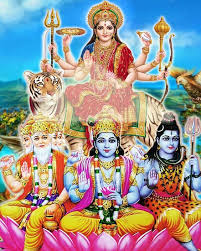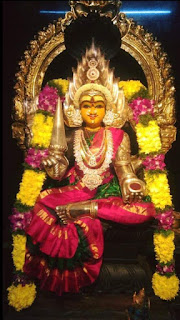त्रिपुरा (626)
Tripurā
She is in the form of all triads, Brahma, Viṣṇu and Rudra; Icchā, jñāna and kriyā śakti-s; the three kūṭa-s of Pañcadaśī; creation, sustenance and destruction; the three nādi-s, iḍā, piṅgala and suṣumna; three worlds, bhūr, bhuva, suvaḥ; three guṇa-s sattvic, rajasic and tamsic. She is in the form of all such triads and once these triads are transcended, the Brahman is attained.
त्रिजगद् वन्द्या (627)
Trijagad vandyā
She is worshipped in all the three worlds viz. bhūr, bhuvar, suvar.
त्रिमुर्तिः (628)
Trimurtiḥ
Trimurti-s are Brahma, Viṣṇu and Rudra. She is the combined form of these three Gods.
त्रिदशेश्वरी (629)
Tridaśeśvarī
She is Īśvarī to all gods and goddesses who are known as tri-daśa, because they are eternally ever youthful. She is the chief of all tri-daśa-s .
त्र्यक्षरी (630)
Tryakṣarī
She is in the form three bīja-s. For example, Bālā mantra has three bīja-s – aiṁ - klīṁ- sauḥ (ऐं- क्लीं- सौः). In ṣodaśī mantra, the three kūṭa-s of Pañcadaśī are treated as three bīja-s.
दिव्य-गन्धाढ्या (631)
Divya-gandhāḍhyā
She is endowed with divine fragrance.
सिन्दूर-तिलकाञ्चिता (632)
Sindūra-tilakāñcitā
She is adorned with vermillion mark on Her forehead.
उमा (633)
Umā
Her name is Umā. She is the wife of Maheśvara and is known as Umā Maheśvara. Umā means splendour of Śiva. One’s will power in constant commune with Śiva is also known as Umā. The anāhata sound of heart cakra is also known as Umā. Six year old girl is known as Umā.
शैलेन्द्र-तनया (634)
Śailendra-tanayā
Daughter of king of mountains, Himavān.
गौरी (635)
Gaurī
She is in golden colour, a combination of white and yellow.
A ten year old girl is known as Gaurī.
ग़न्धर्व-सेविता (636)
Gandharva-sevitā
She's worshiped by Gandharvas who are celestial singers.
विश्व-गर्भा (637)
Viśva-garbhā
She has the universe in Her womb.
स्वर्ण-गर्भा (638)
Svarṇa-garbhā
She has the golden egg in her womb.
अवरदा (639)
Avaradā
She is the destroyer of evil doers, known as demons. Evil doer does not merely mean the one who indulges in evil acts. It also means those who have evil thoughts. Evil thoughts culminate in evil actions.
वागधीश्वरी (640)
Vāgadhīśvarī
She is the ruler of speech.
ध्यान-गम्या (641)
Dhyāna-gamyā
She can be attained by meditation.
अपरिच्छेद्या (642)
Aparicchedyā
She is incomprehensible hence, infinite. She is ubiquitous, the unique quality of the Brahman.
ज्ञानदा (643)
Jñānadā
She is the giver of knowledge, the kind of knowledge that is needed to realize Her absolute form.
ज्ञान-विग्रहा (644)
Jñāna-vigrahā
Her body itself is knowledge.
सर्व-वेदान्त-संवेद्या (645)
Sarva-vedānta-saṁvedyā
She is known through Vedanta.
सत्यानन्द-स्वरूपिणी (646)
Satyānanda-svarūpiṇī
She is in the form of truth (satya) and eternal happiness (ānanda).
लोपामुद्रार्चिता (647)
Lopāmudrārcitā
Lopāmudrā is the wife of sage Agastya. This nāma says that She is worshipped by Lopāmudrā.
लीला-क्लृप्त-ब्रह्माण्ड-मण्डला (648)
Līlā-klṛpta-brahmāṇḍa-maṇḍalā
She handles creation of the universe with ease, as if it is a sport. She framed rules and regulations for the three acts, creation, sustenance and death. The divine law is the ‘law of karma’. Since She is not transgressing the law framed by Her, She finds Her job easy.
अदृश्या (649)
Adṛśyā
She is invisible. She cannot be seen through biological eyes or any other senses. She can only be realized in consciousness, as She is so subtle and is beyond visual perception.
दृश्यरहिता (650)
Drśyarahitā
She transcends visibility. She is in the form of supreme knowledge that is beyond comprehension.
विज्ञात्री (651)
Vijñātrī
She is the knower. She knows all. Knowing it all is an exclusive quality of the Brahman. She is Absolute, an embodiment of knowledge.
वेद्यवर्जिता (652)
Vedyavarjitā
She has nothing to know, again a quality of the Brahman. She is omniscient. This is an affirmation to the previous nāma.
योगिनी (653)
Yoginī
She is the in the form of yoga. Yoga means the union of Self and self.
This nāma could also be referring to the yogini-s who preside over the nine āvaraṇa-s (roundabouts) of Śrī Cakra.
Yogini also refers to a particular time-effect in Indian astrology.
Yogini-s like ḍākinī control seven cakra-s of the cerebro-spinal system that has already been discussed in this Sahasranāma (introduction to yogini-s and in nāma-s 475 to 534)
योगदा (654)
Yogadā
She bestows yoga on Her devotees. The desire for yoga (union of soul with God) arises because of Her grace.
योग्या (655)
Yogyā
She can be attained by yoga. She is yoga Herself, She is the giver of yoga and can be attained by yoga.
योगानन्दा (656)
Yogānandā
She is in the form of bliss that is attained through yoga.
युगन्धरा
Yugandhara (657)
‘Yuga’ means a time period. The existence of the universe is divided into four time periods. Several years form a yuga. The four yugas are satya yuga (also known as krta yuga), treta yuga, dvapara yuga and kali yuga. Each yuga said to consist of millions of years forming a cycle and the total period of all yugas is 4.32 million years. At the end of this cycle, maha-pralaya or the great dissolution (annihilation) takes place and the next cycle of creation begins. She is the controller of this cycle of time.
इच्छाशक्ति-ज्ञानशक्ति-क्रियाशक्ति-स्वरूपिणी (658)
Icchashakthi-jnanashakthi-kriyashakthi-svarupini
She is in the form of three energies – the energy of will, the energy of wisdom and the energy of action. These energies form a part of “Trishika”. Trishika (tri + ishika) means analysis of three. Tri means three and ishika means ‘Ishvari’, the power, abiding in divine consciousness. She is the controller of all triads in the process of creation.
सर्वाधारा (659)
Sarvadhara
She supports everything in this universe or everything rests on Her.
सुप्रतिष्टा (660)
Supratishta
She is the foundation of all existence.
सदसद्-रूप-धारिणी (661)
Sadasad-rupa-dharini
She is in the form of sat and a-sat. Sat means permanent and a-sat means not permanent.
अष्टमूर्ति: (662)
Ashtamurthi
She is eight fold. Shakthi’s eight forms are known through Brahmi, Maheshvari, Kowmari, Vaishnavai, Varahi, Mahendri, Chamunda and Mahalakshmi.
अजा-जेत्री (663)
Ajā-jetrī
Ajā means ignorance and jetri means victory. She has overcome ignorance. After all, She is the embodiment of knowledge and where is the question of ignorance in Her?
लोक-यात्रा-विधायिनी (664)
Loka-yātrā-vidhāyinī
The three acts of God are referred as loga-yātrā which means the journey of the world. physical body begins its journey into this world by birth, nourished by the act of sustenance and destroyed by death. This happens continuously. She is responsible for this cycle of birth-death-rebirth.
एकाकिनी (665)
Ekākinī
She is alone. All the three acts of Divine creation, sustenance and dissolution are done by Her all alone.
भूमरूपा (666)
Bhūmarūpā
Bhūma means the Brahman. She is in the form of Brahman.
निर्द्वैता (667)
Nirdvaitā
She is without duality. Dvaita means two, which means dualism.
द्वैत-वर्जिता (668)
Dvaita-varjitā
She is devoid of duality.
अन्नदा (669)
Annadā
‘Annam’ means food. She is the provider of food to the universe for its sustenance.
वसुदा (670)
Vasudā
She is the giver of wealth. Vasu means precious metals, stones and that kind of wealth.
Vasu has other meanings as well such as excellent, good and beneficent.
वृद्धा (671)
Vṛddhā
She is said to be oldest. Śiva created Her and She created others. But She is beyond aging, a process applicable to all mortals. She is beyond modifications. This nāma means Her primordial nature.
ब्रह्मात्मैक्य-स्वरूपिणी (672)
Brahmātmaikya-svarūpiṇī
The nāma can be arranged as follows. Brahman + ātman + aikya + sva + rūpiṇī. Brahman means Śiva, ātman means jīva or the soul, aikya means combined, sva means haṃsa mantra and rūpiṇi means Her form. This means that She is in the form of haṃsa mantra, which unites the self with the Self (soul with the Brahman).
बृहती (673)
Bṛhatī
She is great.
ब्राह्मणी (674)
Brāhmaṇī
Śiva belongs to Brahmin community. Hence He is called Brāahmaṇā and his wife is Brāahmaṇī.
ब्राह्मी (675)
Brāhmī
Brāhmī is the Goddess of speech and also known as Sarasvatī. Brāhmī is said to be the feminine gender of Brahman. Brahman – Brāhmī. This is like Bhairava and Bhairavī. She is one of the aṣṭa mātā-s.
ब्रह्मानन्दा (676)
Brahmānandā
She is in the form of eternal bliss.
बलि-प्रिया (677)
Bali-priyā
Bali means offering daily, a portion of a meal to all creatures. This is also known as bhūta yajñā. She is fond of those who make such offerings to creatures daily .
भाषा-रूपा (678)
Bhāṣā-rūpā
She is in the form of languages. She is the cause for learning and understanding. She is the Śabda Brahman.
बृहत्-सेना (679)
Bṛhat-senā
She has a mighty army. She administers the universe with the help of this army.
भावाभाव-विवर्जिता (680)
Bhāvābhāva-vivarjitā
She is free from existence as well as non-existence. Bhāva and abhāva are the terms of Vedanta. Bhāva means existence and abhāva means non-existence.
सुखाराध्या (681)
Sukhārādhyā
She can be worshipped without undergoing any difficulties.
शुभकरी (682)
Shubhakarī
She always does good things for Her devotees.
शोभना-सुलभा-गतिः (683)
Śobhanā-sulabhā-gatiḥ
Śobhana means anything propitious or auspicious. sulabh means easily accessible or attainable and gati means path. The path of worshipping Her easily provides salvation or liberation.
































